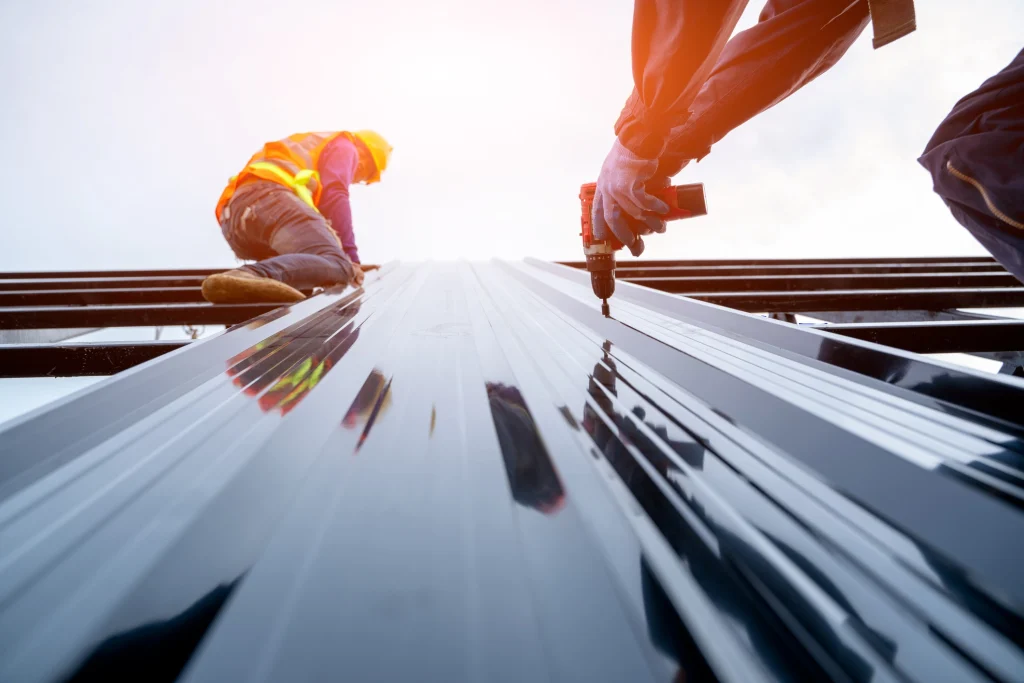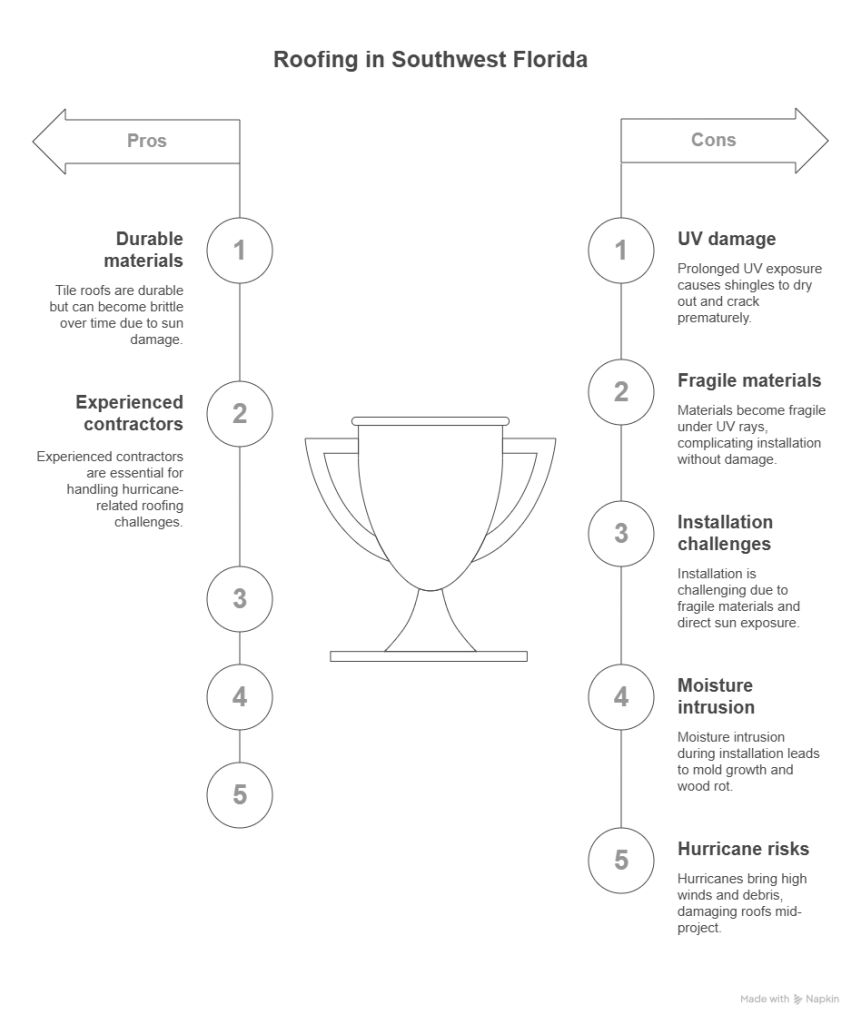3 Common Challenges Faced During Roof Replacements in Southwest Florida
Posted: May 19th, 2025

Replacing a roof in Southwest Florida isn’t just a matter of picking materials and setting a date—it’s a strategic project that must account for the region’s extreme weather patterns, strict building codes, and year-round climate pressures. From the blazing sun to hurricane-force winds, this area presents challenges that can impact everything from material selection to installation timelines. Homeowners and contractors alike need to navigate not just the logistics of roof replacement, but also the environmental forces that make the process more complex than in other parts of the country.
Climate and Weather-Related Challenges
Intense Sun and UV Radiation
One of the most aggressive and constant forces affecting roofs in Southwest Florida is the sun. Prolonged exposure to UV rays can cause shingles to dry out, curl, warp, or crack well before their expected lifespan. Tile roofs, though more durable, can also become brittle over time due to consistent sun damage.
This relentless UV exposure doesn’t just wear out roofs prematurely—it also complicates the replacement process itself. Materials can become more fragile during handling, making them harder to install without damage. Contractors must take extra care when working under direct sun, which can also pose safety risks for crews during mid-day hours.
Heavy Rainfall and High Humidity
Southwest Florida’s rainy season brings near-daily storms and persistently high humidity levels, especially from May through October. These wet conditions create a real challenge when it comes to keeping a roof dry during replacement work.
Moisture intrusion during the installation phase can lead to serious issues, such as water seeping into the underlayment or decking. Even a short afternoon storm can halt progress, cause delays, or worse—trap moisture in roofing layers, setting the stage for future mold growth and wood rot. Contractors often have to work in tight windows between storms and implement additional safeguards to protect the exposed roofing structure.
Hurricane and Tropical Storm Risks
Perhaps the most dramatic threat to roofing projects in Southwest Florida is hurricane season, which spans from June through November. Tropical storms and hurricanes can bring winds in excess of 100 mph, torrential rainfall, and flying debris—any of which can damage a roof mid-project or derail the timeline entirely.
If a storm is forecasted during a replacement, contractors may need to implement temporary coverings or halt work altogether. In some cases, emergency repairs become necessary just to stabilize the home until full replacement can resume. This unpredictable element makes scheduling and planning critical—and it’s one of the biggest reasons why experienced, hurricane-savvy roofing contractors are essential in this region.

Get Your No-Obligation Quote
Environmental and Structural Complications to Roof Replacement
Vegetation and Clogged Drainage
Thanks to Florida’s subtropical climate, vegetation grows fast—really fast. Overhanging branches, fallen leaves, moss, and even palm fronds can quickly clog gutters, roof valleys, and drainage systems. During a roof replacement, this buildup can create unexpected obstacles, especially if it’s hiding pre-existing damage or restricting water flow.
Clogged drainage leads to water pooling on the roof surface, which increases the risk of leaks and structural issues. If these areas aren’t addressed during the replacement, homeowners may find themselves facing water intrusion or premature roof failure shortly after install. That’s why a thorough inspection and cleaning of drainage paths is a critical part of the process in Southwest Florida.
Damaged or Inadequate Flashing
Flashing is one of those components that often gets overlooked—until it fails. In Southwest Florida, damaged, corroded, or improperly installed flashing around chimneys, vents, and roof valleys is a leading cause of roof leaks. And during a replacement project, contractors frequently discover flashing issues that weren’t visible during initial inspections.
Fixing or replacing flashing can extend the timeline and add to the budget, but skipping it is a recipe for disaster. In a region with frequent downpours and high humidity, ensuring flashing is watertight and correctly integrated into the roofing system is absolutely essential.
Mold, Algae, and Pest Infestations
Florida’s signature humidity doesn’t just slow down roofing projects—it creates the perfect breeding ground for mold, algae, and pests. Roof decking, underlayment, and even insulation can become compromised when trapped moisture or poor ventilation leads to fungal growth. In some cases, contractors uncover widespread mold during the tear-off phase, requiring remediation before work can proceed.
Black streaks from algae are also common on older roofs, and if not addressed during replacement, they can reappear quickly. And let’s not forget about pests—ants, termites, and even rodents often find shelter in weakened roof areas. These infestations complicate the job, as damaged wood or insulation must be removed and replaced to ensure a solid, pest-resistant roof system going forward.
Project Logistics and Material Considerations
Material and Labor Shortages
After major storms or during periods of high demand, it’s not uncommon for Southwest Florida to experience material and labor shortages. Preferred roofing products—especially impact-resistant shingles or high-end metal and tile—may be backordered for weeks. And skilled labor? Even harder to come by, particularly after a hurricane when every roofer is booked solid.
This scarcity can delay projects or force homeowners to compromise on materials. Some contractors may offer substitutions, but that can affect warranty coverage or long-term performance. Planning well in advance and working with a reputable contractor who has reliable supplier connections is key to avoiding unnecessary delays.
Code Compliance and Insurance Requirements
Florida’s building codes are some of the strictest in the country, especially when it comes to roofing. Homes in Southwest Florida must meet specific standards to withstand hurricane-force winds, and any roof replacement must be done in compliance with these codes. That includes things like specific fastening patterns, underlayment types, and uplift resistance ratings.
Navigating the permitting process and meeting inspection requirements can slow a project if your contractor isn’t up to speed. Additionally, insurance companies often require detailed documentation and may only provide discounts for roofs that meet certain criteria. Failing to meet these requirements can affect both your home’s safety and your wallet.
Get Your No-Obligation Quote
How to Overcome These Roofing Challenges
Work with Licensed Local Roofing Contractors
In Southwest Florida, experience matters. Hiring a licensed roofing contractor who’s familiar with local building codes, climate patterns, and permitting processes can make or break your roof replacement. These professionals understand how to time projects around weather, avoid common pitfalls like poor flashing installation, and ensure your roof meets all state and insurance requirements. Ask for references, confirm licensing (such as a Florida CCC or CGC license), and choose a contractor with a proven track record in your area.
Choose Climate-Appropriate Materials
Not all roofing materials perform equally in Florida’s extreme weather. UV-resistant shingles, Class 4 impact-rated tiles, and metal roofing systems designed for high wind zones offer better protection and longevity. Reflective coatings can also help reduce heat absorption and lower energy costs. Investing in the right materials upfront—especially those engineered for hurricane-prone regions—can prevent future damage and save you money long-term.
Plan Around Hurricane Season and Demand Peaks
Timing is everything in Florida roofing. Scheduling your project between December and April—the dry season—can minimize weather-related delays and give you more contractor availability. Avoiding peak hurricane season (June–November) also reduces the risk of storm interruptions. Booking early in the dry season or right after it ends can help you lock in better rates and avoid the rush that follows summer storms.
Summary Table – Top Roofing Challenges in SW Florida
| Challenge | Why It Matters | How to Address It |
| UV Exposure | Causes shingles and tiles to crack, curl, and degrade faster | Use UV-resistant materials and install during cooler hours |
| Humidity & Rain | Leads to water damage, mold growth, and delays during installation | Schedule during dry season and use moisture barriers |
| Hurricanes & Tropical Storms | Storms can halt progress or damage roofs mid-installation | Avoid hurricane season and secure work-in-progress areas |
| Temperature Fluctuations | Expansion and contraction cause stress fractures and sealing issues | Use flexible adhesives and temperature-appropriate materials |
| Clogged Drainage | Water pooling leads to leaks and structural issues | Clear gutters and valleys before installation |
| Flashing Problems | Leaks and water intrusion from old or damaged flashing | Inspect and replace flashing during roof tear-off |
| Mold, Algae & Pests | Weakens materials and delays replacement timeline | Remove affected areas and treat for long-term protection |
| Material & Labor Shortages | Can cause delays or force compromises on material selection | Book early and work with contractors who have strong supplier access |
| Code Compliance | Failing inspection or missing code requirements can void insurance or cause delays | Hire licensed contractors familiar with Florida codes |
Final Thoughts
Roof replacements in Southwest Florida come with a unique set of challenges—from brutal sunshine and torrential rain to code compliance and seasonal storm threats. But with proper planning, smart material choices, and an experienced local roofing contractor, these obstacles can be managed with confidence.
Whether you’re preparing for a full roof replacement or just exploring your options, timing and preparation are everything. Start early, do your research, and work with professionals like San Carlos Roofing who know the ins and outs of roofing in Florida’s high-stakes environment.



